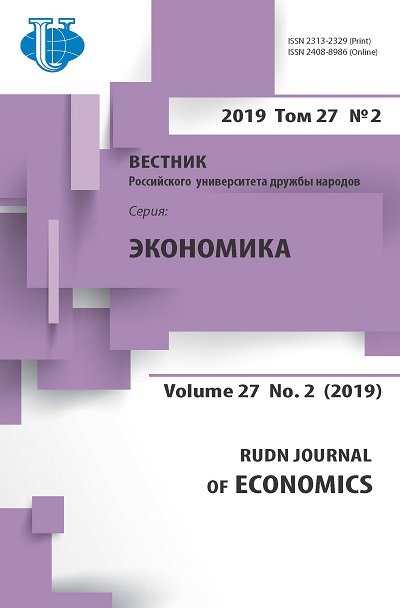Classification of integration associations according to the degree of development of a single transport space
- Authors: Komov M.S1
-
Affiliations:
- Russian University of Transport
- Issue: Vol 27, No 2 (2019)
- Pages: 375-385
- Section: GLOBALIZATION AND ECONOMIC INTEGRATION
- URL: https://journals.rudn.ru/economics/article/view/22187
- DOI: https://doi.org/10.22363/2313-2329-2019-27-2-375-385
Cite item
Full Text
Abstract
In modern conditions of development of integration processes in the world economy, special importance is attached to the transport sector. The formation of a single transport space (STS) in the regions creates additional opportunities for the economic development of the integrating countries. At the same time, the literature does not pay enough attention to the definition of the essence of the single transport space and the classification of integration associations according to the degree of its development. Therefore, there is a need to develop such a classification. The article substantiates the expediency of classification of integration associations according to the degree of development of a single transport space. The author's formal-logical classification is developed, which is based on three basic types of a single transport space: transport and logistics type provide a positive multiplier of integrated economic growth for all participating countries; innovative-logistic and customs-logistic types cause polarization in the action of the multiplier of integrated economic growth (in particular, both positive and negative growth rates of GDP values of the participating countries are possible); industrial and logistics type provide a zero multiplier of integrated economic growth for all participating countries. The conclusion is made about the possibility of unification and harmonization of transport space in the practice of integration associations on the basis of the developed classification.
About the authors
Mikhail S Komov
Russian University of Transport
Author for correspondence.
Email: komovms@mail.ru
Cand. Sc. (Econ.), Associate Professor
9 Obraztsova St., bldg. 9, Moscow, 127994, Russian FederationReferences
- Andreev V.K. (2017). Perspektivy i ehtapy formirovaniya edinogo transportnogo prostranstva v EAEHS i SNG [Prospects and stages of formation of a single transport space in the EAEU and the CIS]. Mezhdunarodnoe sotrudnichestvo evrazijskih gosudarstv: politika, ehkonomika, parvo, (11), 50–59. (In Russ.)
- Baeva M.A., Knobel' A.Y., Zajcev Y.K., Loshchenkova A.N. (2018). Vliyanie zashchitnyh mer v integracionnyh ob’edineniyah na mezhdunarodnuyu torgovlyu [Impact of protective measures in integration associations on international trade]. Moscow, Delo Publ. (In Russ.)
- Balassa B. (1961). The Theory of Economic Integration. London.
- Bondarev I.I. (2017). Trudnosti razvitiya integracionnyh ob’edinenij (na primere EAEHS i MERKOSUR) [Difficulties in the development of integration associations (a case study of the EAEU and MERCOSUR)]. Ehkonomika, upravlenie, finansy: materialy VII Mezhdunar. nauch. konf. (Krasnodar, fevral' 2017) (pp. 14–17). Krasnodar, Novaciya Publ. (In Russ.)
- Denyak O.A. (2015). Faktory razvitiya regional'nyh transportnyh sistem [Factors in the development of regional transport systems]. Logistika: sovremennye tendencii razvitiya: materialy XIV Mezhdunarodnoj nauchno-prakticheskoj konferencii (9–10 aprelya 2015) (pp. 146–148). Saint Petersburg. (In Russ.)
- Grigor'eva I. (2015). Mirovoj ehkonomike grozit zamedlenie: tempy ee rosta snizyatsya do 3,2% [The world economy faces a slowdown: its growth rate will fall to 3.2%]. Retrieved from https://iz.ru/795273/inna-grigoreva/mirovoi-ekonomike-grozit-zamedlenie-tempyee-rosta-sniziatsia-do-32. (In Russ.)
- Haas E.B. (1958). The Uniting of Europe: Political, Social and Economic Forces: 1950–1957. Stanford University Press.
- Karachev A.N. (2004) Logistika razmeshcheniya torgovyh predpriyatij [The logistics of placing of commercial enterprises] (abstract of Thesis of Candidate of Economic Sciences). Saint Petersburg. (In Russ.)
- Komov M.S. (2018). Rol' transporta v razvitii regional'nyh integracionnyh processov v mirovoj ehkonomike [The role of transport in the development of regional integration processes in the world economy]. Regional'nye problemy preobrazovaniya ehkonomiki, 8(94), 192–199. (In Russ.)
- Koroleva E.A. (2017). Transportnoe prostranstvo: sushchnost' i struktura [Transport space: nature and structure]. Transport business in Russia, (3), 31–33. (In Russ.)
- Lapidus B.M., Macheret D.A. (2012). Ehkonomika transportnogo prostranstva: metodologicheskie osnovy [Transport space economics: methodological basis]. Vestnik nauchnoissledovatel'skogo instituta zheleznodorozhnogo transporta, (2). Moscow, Nauchnoissledovatel'skij institut zheleznodorozhnogo transporta. (In Russ.)
- Larin O.N. (2017). Perspektivy integracii transportnyh sistem Evrazijskogo ehkonomicheskogo soyuza [Prospects of integration of transport systems of the Eurasian Economic Union]. Problemy nacional'noj strategii, 4(43). Retrieved from https://riss.ru/images/ pdf/journal/2017/4/11.pdf. (In Russ.)
- Lindberg L. (1953). The Political Dynamics of European Economic Integration. Stanford.
- Makashina I.I. (2017). Konkurentosposobnost' obrazovatel'nyh uslug morskogo universiteta kak faktor kachestvennogo funkcionirovaniya transportnogo prostranstva [Competitiveness of educational services of Maritime University as a factor of quality functioning of transport space]. Trud i social'nye otnosheniya, (4), 45–50. (In Russ.)
- Satty M. Putt. (2018). Transport: the establishment of a single transport space within integration groupings. Research reports, International Firm Ernst and Young. London.
- Wallace W. (1990). The Dynamics of European Integration. London.
- Zuenko I.Y., Zuban' S.V. (2016). Transkontinental'nyj tranzit Aziya – Evropa [Transcontinental transit Asia – Europe]. Mirovaya ehkonomika i mezhdunarodnye otnosheniya, 7(60), 70–76. (In Russ.)
- Zuenko I.Y., Zuban' S.V. (2017). Kitaj i EAES: dinamika transgranichnogo dvizheniya tovarov i budushchee evrazijskoj integracii [China and the EAEU: dynamics of crossborder movement of goods and the future of Eurasian integration]. Tamozhennaya politika Rossii na Dal'nem vostoke, 2(79), 5–24. (In Russ.)















